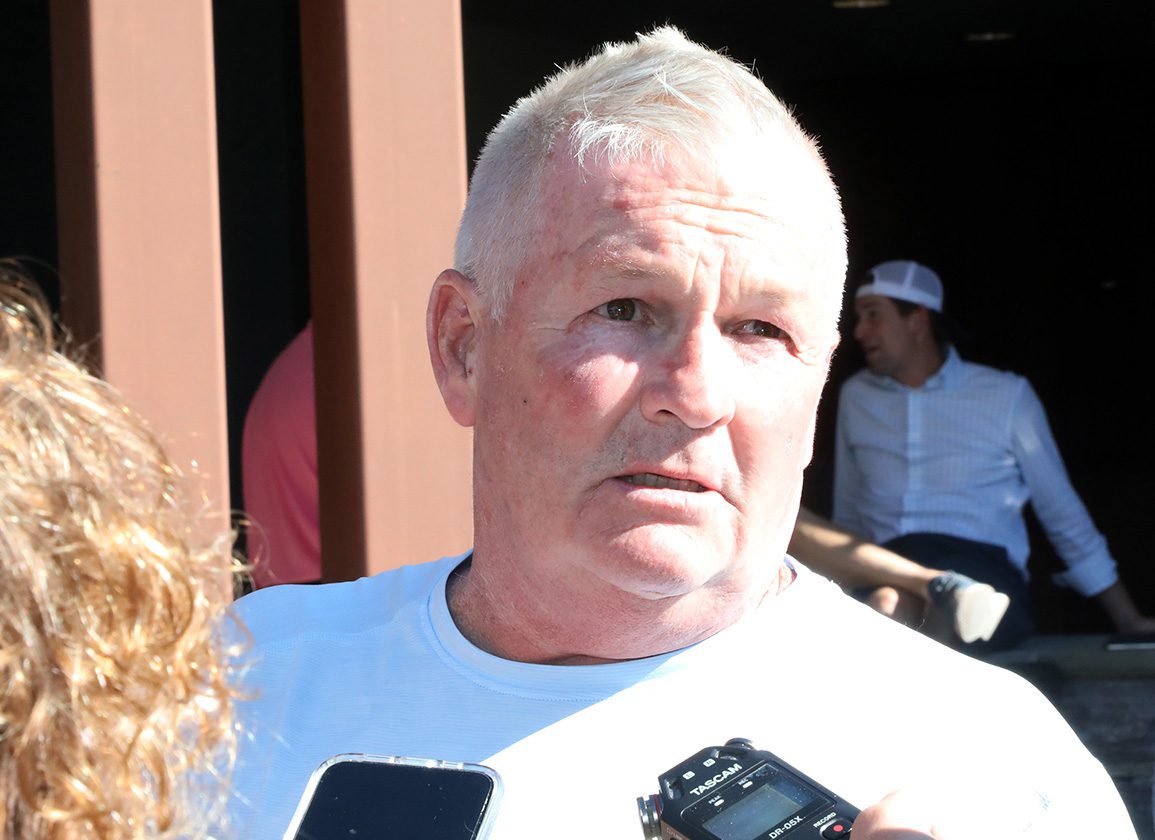By Jessica Martini
The TDN sat down with 2-year-old consignor Tom McCrocklin for this first offering in a new series presented in cooperation with the Consignors and Breeders Association (CBA). Through conversations with buyers and sellers, the series looks to contribute to the discussion on radiograph findings and their impact on racetrack success.
Tom McCrocklin, who was represented this spring by graduates in both the GI Kentucky Derby and the GI Kentucky Oaks, as well as by a pair of million-dollar juveniles in the sales ring, admitted his approach to vet work varies greatly whether he is shopping for a racehorse prospect or for a potential pinhook prospect.
“It's a very clear distinction when I buy a racehorse for myself or I buy a prospective pinhook horse,” the Ocala horseman said. “With the racehorses, I have a pretty good feel of what I can and cannot live with anymore. I feel like I've got my brain wrapped around what young horses can live with and move on with and be racehorses. And then I have the other category of pinhook horses where I know I will have to make buyers and buyers' vets on the other end happy. Then it doesn't matter what I think and what I feel like I know. It matters what they think and what they want.”
McCrocklin said veterinarian scrutiny of the horses in his 2-year-old consignments has only become more stringent in recent years.
“The diagnostics done on the sales grounds pre-purchase are off the charts,” he said. “I will give you a perfect example. The genie is out of the bottle now with ultra-sounding and ultra-sounding so many structures. These vets are all on a kick now where they want to ultrasound eight suspensory branches and four tendons and four proximal suspensories, which is a lot of soft tissue structure. The long and the short of it is this, in this age group, 2-year-olds in training, under pressure, breezing, very few are going to have pristine ultrasounds. They are almost all going to have some commentary; all ranges of everything from swelling to fiber disruption to actual tears. And they are learning as they go–just like me as a consignor–that we are going to get to where we can't sell many horses if the vets are going to expect perfection.”
McCrocklin purchased Kingsbarns (Uncle Mo) for $250,000 at the 2021 Fasig-Tipton Saratoga sale and sold the future GII Louisiana Derby winner and Kentucky Derby runner for $800,000 at the 2022 Fasig-Tipton Gulfstream sale. And he is co-owner of GIII Gazelle S. winner and Kentucky Oaks runner Promiseher America (American Pharoah). He said the proof of the vet report lies in the performance of horses like those on the racetrack.
“I compare the ultrasounds to their race records,” McCrocklin said. “I personally had a filly in the Oaks this year and I personally sold a horse that ran in the Derby this year and they both had soft tissue pathology at the 2-year-olds in training sale. They were both given 30-60 days after the sale and they both wound up being fine. A lot of very good, sound racehorses have significant radiographic and ultrasound pathology. They have it at the 2-year-old sale and they have it throughout their racing careers and a lot of them are very sound horses.”
He continued, “I had this conversation with Bob Baffert. 'I tell you what, you pick the 10 soundest horses in your barn–not the 10 best, but the 10 horses that you perceive to be the soundest ones. And you go through those 10 horses and you X-ray everything and you ultrasound everything and do everything these guys are doing at the 2-year-old sales and it will blow your mind what those horses have on radiographs and ultrasounds. You will not believe what you find. And the first thing you are going to say to me is the same thing I am going to say to you at my consignment. I don't know what to tell you, I've been training this horse for six months and he's never had a bad day and he's never had a gram of bute, he's never taken a bad step, he's never worn a bandage. And here you come with all of your machines and when you are done, I want to start crying.'”
Once McCrocklin buys a yearling in the fall, he will spend the rest of the year and early spring working with the youngster. That experience gives him a unique perspective on both the horse's potential and his limitations.
“So many of these horses on all ends are being bought by agents,” he said. “These guys are really bright and they are good horse buyers. I am in no way criticizing them for the decisions they make, but one distinction between us is that I am in my horse laboratory every day in my barn. I put my hands on horses and I am training horses and I am putting young horses under significant pressure to buy them in September or October and make a 2-year-old in training sale in March. They show up in September, October and August and they are on the buying end. And they come back in March, April, June and they are on the buying end again. What gets lost along the way is everything that happens on a daily basis in the six to eight months in between. And there is a significant amount of knowledge and education that comes with that process.”
Asked for specific examples of issues with yearlings that will knock them out of his pinhooking portfolio, but not necessarily his racing stable, McCrocklin said, “Subcondylar cysts in cannon bones–basically a hole in the cannon bone that you are never going to be able to sell as a 2-year-old–subcondylar cysts in a stifle, which would basically be a femur. I can live with those horses because I've trained so many of them that they are fine. But you take that horse to a 2-year-old sale and you are dead, you're absolutely dead. So I can't buy them anymore.”
McCrocklin's biggest vexation, he said, was the variance of opinions on throats.
“When we're looking in a horse's throat with a scope, everyone has a different opinion,” McCrocklin said. “Some people like this, some people like that. On these real popular horses, you can have 10 to 20 scopes and I can have 10 guys come in and say, perfect, perfect, perfect and then the 11th vet comes in, a really reputable vet, and says this horse flunks miserably. It is not black and white, it's far from it.
“But here's what I can tell you, again, as a horse trainer, not as a buyer, not as a seller, I have a lot of horses that scope fine and they can't breathe and I have horses that scope like shit and they breeze great, never made a noise, they get their air, they don't make noise when they are breezing. Again it's very mysterious because we keep those vet books at our consignment and it says Grade I, everybody loves it, and I'm thinking I've been training this horse for eight months, this horse can't breathe. The only way to identify those horses that scope great at the barn, but can't breathe is what we call a dynamic scope where we put it on them and we actually view what's happening in their throat while they gallop and or breeze. And we see a lot of crazy things happen in these throats that are good at rest and the horse can't tolerate training. And then we have horses that can't fully abduct, they can't open their arytenoids all the way to clear their airway, but they've never made a noise and they don't have exercise intolerance. And they breeze great.”
McCrocklin's advice to shoppers is to find a vet who knows what's a deal-breaker and what might not hinder a horse's performance on the track.
“The big-picture message is that there are definitely not parallel lines between racing performance and vet work,” he said. “There is a lot of gray in there. What I tell people is get yourself a very experienced–not just a good vet–but an experienced vet that has a body of work and says, 'Look, I've seen a lot of these horses and they can live with this,' and he also has a body of work and he says, 'Look, I've had a lot of these and none of them make it.'”
Not a subscriber? Click here to sign up for the daily PDF or alerts.






